Key takeaways:
- Women’s health advocacy emphasizes the importance of amplifying marginalized voices and recognizing barriers such as stigma, misinformation, and intersectionality.
- Effective advocacy messaging relies on clarity, emotional resonance, and consistency to engage and empower women while countering misinformation.
- Tailoring messages to specific audiences, fostering dialogue, and sharing personal experiences can enhance connection and encourage active participation in advocacy efforts.
- Evaluating message effectiveness through audience feedback and emotional impact is crucial for refining advocacy strategies and ensuring they resonate with listeners.
Understanding women’s health advocacy
Women’s health advocacy is about amplifying voices that have often been sidelined. I recall attending a local community meeting where women shared their health struggles—some felt invisible in the medical system. Listening to their stories, I realized how vital it is to advocate for accurate representation and access to care. What if those stories went unheard?
One essential aspect of women’s health advocacy is understanding the barriers many women face. For instance, when I spoke to a friend who had difficulty accessing reproductive healthcare, it struck me that societal stigma and misinformation play significant roles. If women aren’t informed or supported, how can they take charge of their own health? This realization deepened my appreciation for the role of advocacy in fighting for comprehensive health education.
Advocacy also involves recognizing the intersectionality of women’s experiences—factors like race, socio-economic status, and geography that define their health outcomes. I remember a discussion from a health workshop where a participant shared her struggles as a woman of color navigating the healthcare system. This perspective opened my eyes to the urgent need for tailored messages that resonate with diverse populations. How can we create a narrative that truly represents every woman’s unique journey? Addressing this question is crucial for effective advocacy.
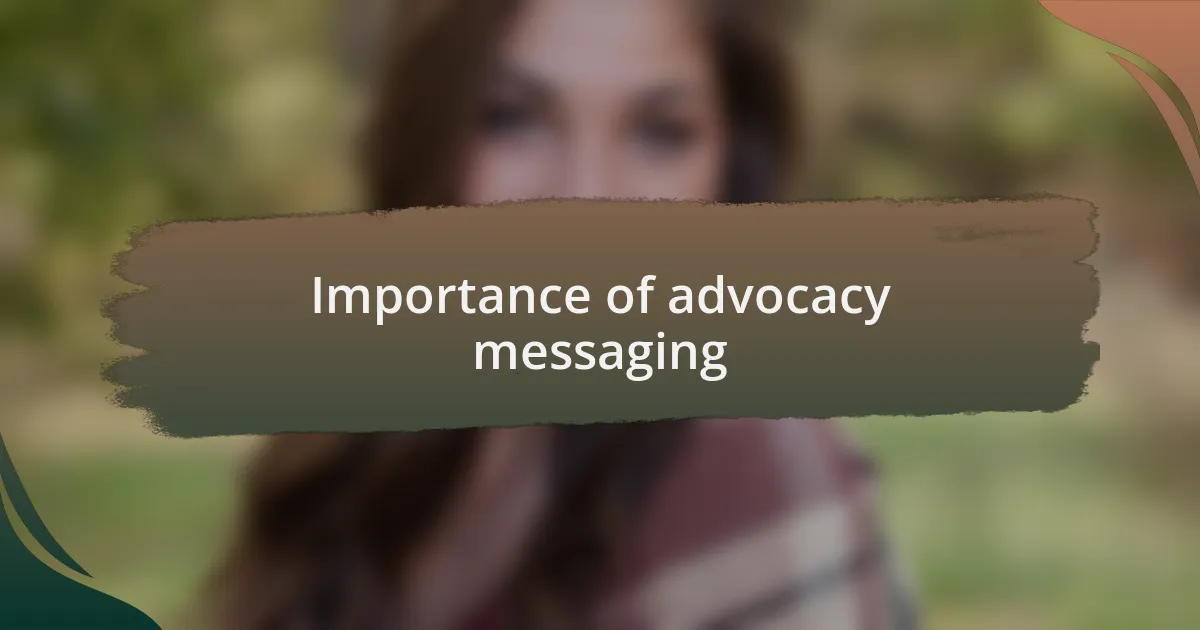
Importance of advocacy messaging
Advocacy messaging plays a critical role in shaping public perception and policy around women’s health issues. I remember a campaign I encountered focused on menstrual health education—seeing how it sparked conversations and brought awareness to a topic once shrouded in silence was eye-opening. Isn’t it empowering to think that effective messaging can transform shame into understanding and support?
The power of clear and impactful advocacy messaging lies in its ability to reach individuals where they are, fostering connection and community. I once participated in a social media initiative that encouraged women to share their health stories, and the response was overwhelming. This communal sharing reminded me that when advocates speak from the heart, their messages resonate deeper, driving people to take action.
Moreover, tailored advocacy messaging enables us to directly counter misinformation and stigma that can hinder women’s health. Reflecting on a workshop I attended, where experts tackled common myths about birth control, I noticed how the audience’s understanding shifted dramatically. This experience reinforced my belief that strategic messaging not only informs but also empowers women to seek the health care they deserve. How can we harness the effectiveness of messaging to create real change? By truly listening to women and amplifying their needs, we position ourselves to answer that call.

Key components of effective messages
Effective messages in advocacy are built on clarity and simplicity. I recall a presentation on cervical cancer prevention, where the speaker emphasized using straightforward language. The audience connected better because complex medical jargon was stripped away, making the information accessible to everyone. Isn’t it fascinating how much difference a few easily understood words can create?
Another vital component is emotional resonance. I once attended a health forum where personal stories of surviving breast cancer were shared. The raw emotion in those narratives not only informed but also inspired action among listeners. It’s clear that when messages tap into our shared experiences and feelings, they foster a deeper sense of urgency and commitment to the cause. How often do we underestimate the power of vulnerability in advocacy?
Lastly, consistency in messaging is crucial. I remember collaborating on a campaign promoting mental health awareness, and we learned early on how vital it was to stick to our core message across all platforms. This consistency reinforced our identity and built trust with our audience. When I look back, I realize that maintaining a uniform approach helps to solidify beliefs and encourage collective action. How can we ensure our messaging remains strong and consistent in the face of evolving challenges? By anchoring our communications to our mission, we can navigate changes while remaining true to our purpose.
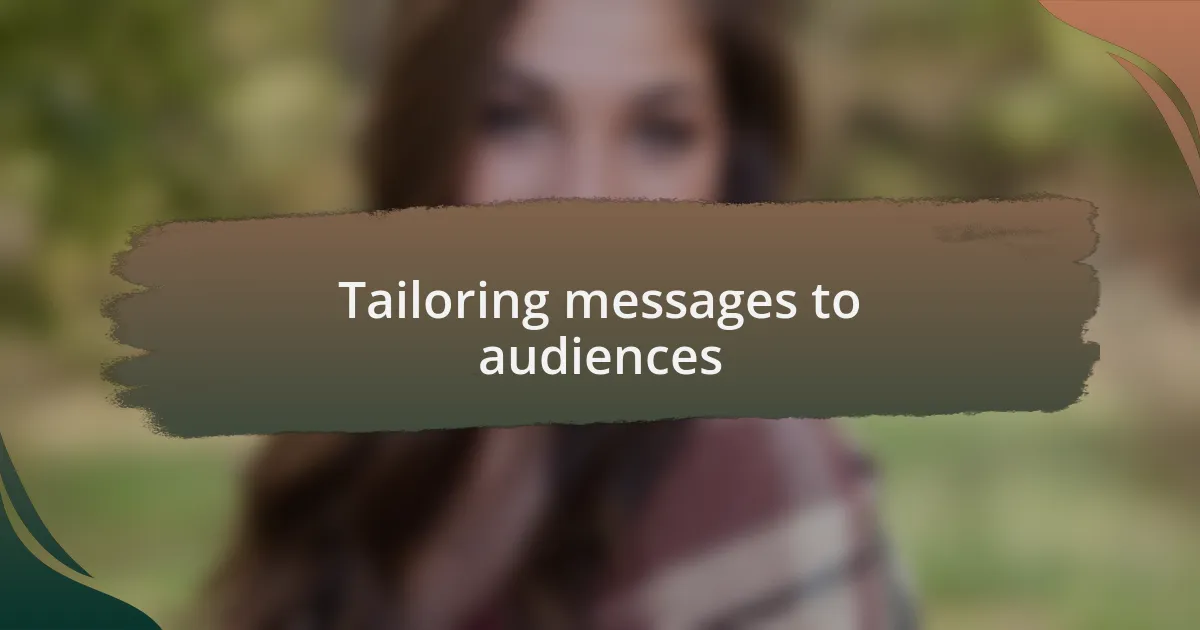
Tailoring messages to audiences
Understanding your audience is essential in advocacy messaging. I remember during a workshop on women’s health issues, one of the participants shared how different cultural backgrounds shaped perceptions about reproductive health. Hearing her speak opened my eyes to the fact that tailoring messages to cultural contexts allows for more meaningful conversations. Have you ever considered how the framing of an issue can resonate differently based on someone’s background?
Demographics also play a significant role in how messages are received. A friend of mine, who works in youth advocacy, often emphasizes the language used when addressing younger audiences. She noticed that incorporating social media trends into her messages not only captured their attention but also encouraged engagement. What if we could harness similar strategies when speaking to various age groups or communities? By reflecting the audience’s realities, we can create messages that truly resonate.
Engaging with the audience directly fosters a sense of ownership over the message. During a community health event I participated in, we had an open dialogue instead of a one-way presentation. Participants were encouraged to share their experiences and thoughts, leading to a richer discussion about women’s health challenges. Isn’t it remarkable how dialogue can transform passive listeners into active advocates? By inviting audience participation, we enhance their connection to the cause and empower them to spread the message further.
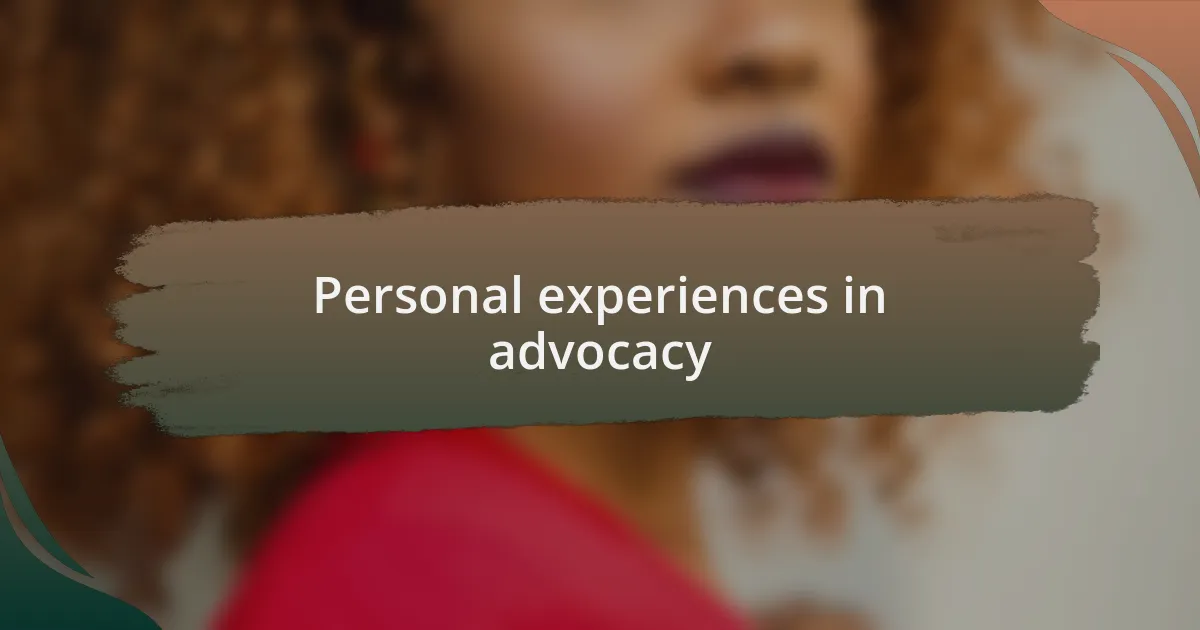
Personal experiences in advocacy
During my time volunteering at a women’s health clinic, I found that sharing my own experiences often broke down barriers. I remember speaking about my struggles with mental health and how societal stigma affected my journey. The moment I saw others nodding in understanding, I realized that personal stories create bonds that facts and figures sometimes can’t.
At a local advocacy event, I took a chance and shared an unexpected consequence of my activism—how my own health transformed as I became more engaged, both physically and mentally. This connection to self-care sparked profound discussions among attendees, leading many to reflect on how their advocacy journeys had shaped their identities. Isn’t it fascinating how our personal growth intertwines with our advocacy efforts?
I once facilitated a workshop where I encouraged participants to visualize their advocacy as a shared narrative. We crafted stories together, revealing how our individual struggles contributed to a larger movement for change. Watching participants realize their collective power was uplifting; it made me think, how often do we underestimate the strength in our collective voices? This experience reinforced my belief that advocacy is not just about the cause; it’s about the community we build around it.
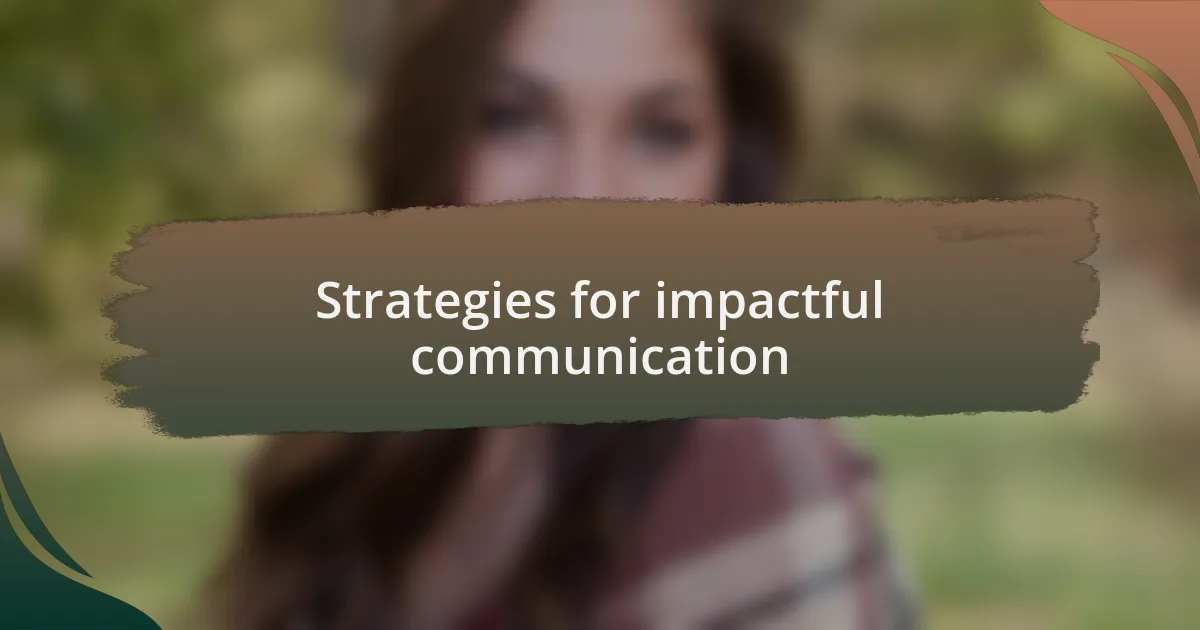
Strategies for impactful communication
To foster impactful communication in advocacy, I’ve learned that clarity is crucial. One time, I was part of a panel discussing reproductive rights, and I made a point to define key terms upfront. This simple step transformed the conversation; suddenly, everyone was on the same page. Have you ever experienced confusion in discussions because of vague language? I have, and it’s frustrating.
Another effective strategy is to tailor your message to your audience. I once prepared a presentation for a group of young women, focusing on access to mental health resources. By integrating relatable examples and avoiding jargon, I realized they felt more connected to the content. It made me ponder: how often do we forget to meet people where they are?
Lastly, the power of visuals can’t be overstated. During a fundraising campaign, I used infographics to illustrate the impact of our work. The visual data resonated deeply, making it easier for potential supporters to grasp the urgency of our mission. Isn’t it intriguing how a compelling image can evoke emotions that words sometimes cannot?
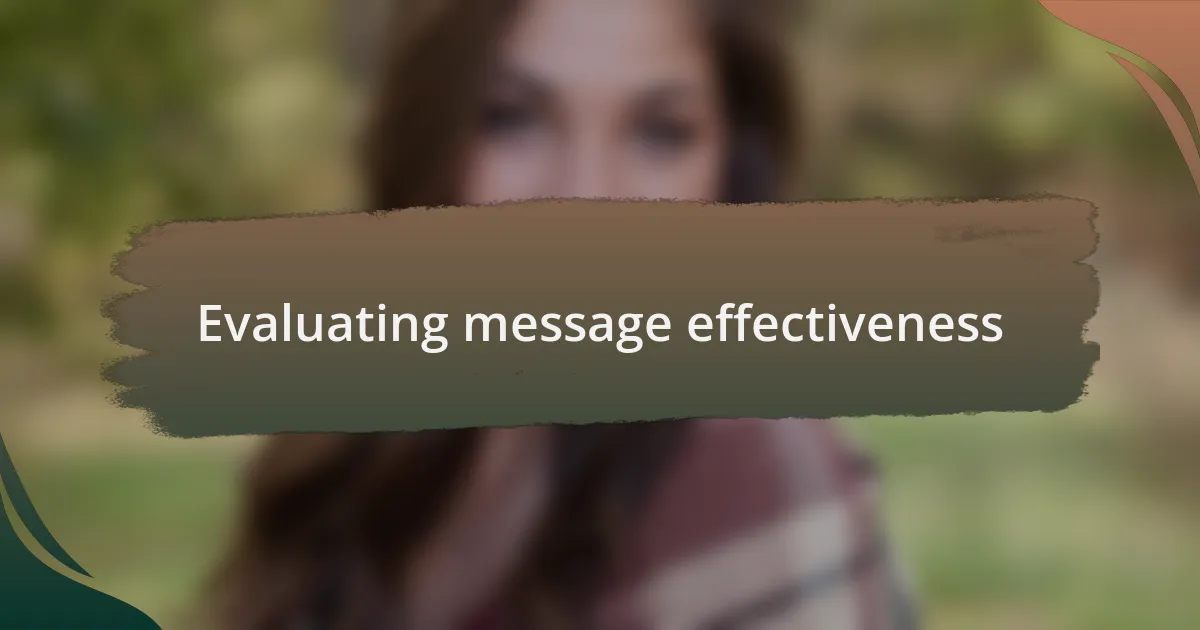
Evaluating message effectiveness
When evaluating message effectiveness in advocacy, it’s essential to gather feedback from the audience. In my experience at a women’s health conference, I distributed a quick survey after my presentation. The results surprised me—while I thought my message was clear, many attendees noted they wanted more examples. It raised an important question for me: Are we really listening to our audience’s needs?
I also find it beneficial to analyze engagement metrics. For example, when I shared a campaign on social media about women’s rights, I closely monitored the shares and comments. It became evident that posts with personal stories received far more interaction than those with purely factual content. Isn’t it fascinating how people connect more deeply with narratives that resonate with their own experiences?
Another aspect to consider is the emotional response your message evokes. I recall a workshop where I asked participants to visualize their reactions to different messages about mental health support. The discussions revealed the powerful impact of emotional storytelling, reminding me that advocacy isn’t just about facts—it’s about touching hearts. How do we ensure our messages inspire change rather than just inform?